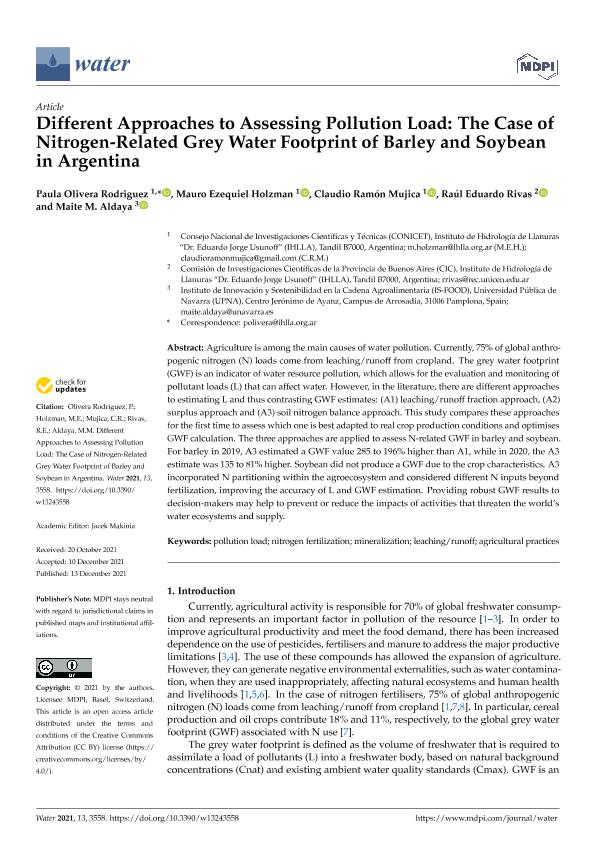Artículo
Different Approaches to Assessing Pollution Load: The Case of Nitrogen-Related Grey Water Footprint of Barley and Soybean in Argentina
Olivera Rodriguez, Paula Sara ; Holzman, Mauro Ezequiel
; Holzman, Mauro Ezequiel ; Mujica, Claudio Ramon
; Mujica, Claudio Ramon ; Rivas, Raúl Eduardo; Aldaya, Maite M.
; Rivas, Raúl Eduardo; Aldaya, Maite M.
 ; Holzman, Mauro Ezequiel
; Holzman, Mauro Ezequiel ; Mujica, Claudio Ramon
; Mujica, Claudio Ramon ; Rivas, Raúl Eduardo; Aldaya, Maite M.
; Rivas, Raúl Eduardo; Aldaya, Maite M.
Fecha de publicación:
12/2021
Editorial:
MDPI
Revista:
Water
ISSN:
2073-4441
Idioma:
Inglés
Tipo de recurso:
Artículo publicado
Clasificación temática:
Resumen
Agriculture is among the main causes of water pollution. Currently, 75% of global anthropogenic nitrogen (N) loads come from leaching/runoff from cropland. The grey water footprint (GWF) is an indicator of water resource pollution, which allows for the evaluation and monitoring of pollutant loads (L) that can affect water. However, in the literature, there are different approaches to estimating L and thus contrasting GWF estimates: (A1) leaching/runoff fraction approach, (A2) surplus approach and (A3) soil nitrogen balance approach. This study compares these approaches for the first time to assess which one is best adapted to real crop production conditions and optimises GWF calculation. The three approaches are applied to assess N-related GWF in barley and soybean. For barley in 2019, A3 estimated a GWF value 285 to 196% higher than A1, while in 2020, the A3 estimate was 135 to 81% higher. Soybean did not produce a GWF due to the crop characteristics. A3 incorporated N partitioning within the agroecosystem and considered different N inputs beyond fertilization, improving the accuracy of L and GWF estimation. Providing robust GWF results to decision-makers may help to prevent or reduce the impacts of activities that threaten the world’s water ecosystems and supply.
Archivos asociados
Licencia
Identificadores
Colecciones
Articulos (IHLLA)
Articulos de INSTITUTO DE HIDROLOGIA DE LLANURAS "DR. EDUARDO JORGE USUNOFF"
Articulos de INSTITUTO DE HIDROLOGIA DE LLANURAS "DR. EDUARDO JORGE USUNOFF"
Articulos(CCT - TANDIL)
Articulos de CTRO CIENTIFICO TECNOLOGICO CONICET - TANDIL
Articulos de CTRO CIENTIFICO TECNOLOGICO CONICET - TANDIL
Citación
Olivera Rodriguez, Paula Sara; Holzman, Mauro Ezequiel; Mujica, Claudio Ramon; Rivas, Raúl Eduardo; Aldaya, Maite M.; Different Approaches to Assessing Pollution Load: The Case of Nitrogen-Related Grey Water Footprint of Barley and Soybean in Argentina; MDPI; Water; 13; 24; 12-2021; 1-19
Compartir
Altmétricas



